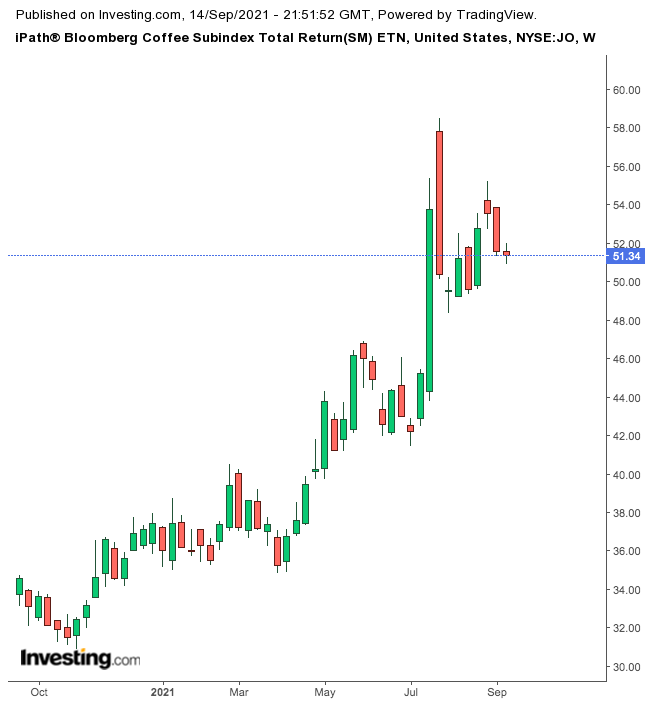Coffee prices hit multi-year highs in 2021. In August, the commodity recorded the 10th consecutive month of surge, mainly due to concerns about weather-related supply constraints and pandemic-triggered freight cost increases.
According to the International Coffee Organization:
“The level reached in August 2021 represented an increase of 51.3% since the start of the current coffee year.”
A ninth-century Ethiopian herder allegedly discovered coffee, thanks to his goats becoming over-energetic after eating berries from a particular tree. As one of the most-traded commodities worldwide, coffee is cultivated in more than 70 countries.
There are four main coffee types: Arabica, which gets the most attention, Robusta, Excelsa and Liberica. Brazil leads coffee production with more than 30% of the world’s cultivation, most of which is Arabica coffee.
Vietnam, Columbia, Indonesia and Ethiopia follow Brazil, together producing around 75% of the world’s coffee. China, India, the U.S. and Indonesia have the highest coffee consumption worldwide.
As consumers enjoy their daily cups of joe, markets pay close attention to coffee prices, which can be unpredictable due to fluctuations in production, freight costs or geopolitical developments. For instance, in late July, coffee prices skyrocketed due to an unexpected frost in Brazil.
Despite the challenges in the industry, trading opportunities still remain strong. Interested readers could invest in the coffee industry through coffee-related stocks in the consumer discretionary and consumer staples sectors, coffee futures or an exchange-traded note (ETN). Let’s take a closer look.
iPath Series B Bloomberg Coffee Subindex Total Return ETN
Current Price: $51.34
52-Week Range: $30.89 - $58.50
Expense Ratio: 0.45% per year
This is an ETN issued by Barclays. We previously covered various characteristics of ETNs, like the counter-party risk of its issuer, i.e. Barclays in this case.
The iPath® Bloomberg Coffee Subindex Total Return (SM) ETN (NYSE:JO) gives exposure to coffee prices via futures contracts on the commodity. The ETN started trading in January 2018, and net assets stand at $100.5 million.

JO tracks the Bloomberg Coffee Subindex Total Return index, which currently comprises one futures contract on the commodity. This soft commodity trades on the Intercontinental Exchange in the futures market, where “The Coffee C contract is the world benchmark for Arabica coffee.” Soft commodities are those grown, rather than mined.
Such futures contracts are typically rolled according to a fixed schedule. We should remind readers that a futures-based index might not fully track the results on spot coffee prices. Nonetheless, JO still offers a viable way to invest in coffee through an unleveraged investment in futures.
So far this year, the ETN has returned close to 37% and hit a record high in late July. The 52-week low of $30.89 was seen in early November. Coffee bulls should do further due diligence on the commodity and the ETN with a view to buying the dips.
Readers might also be interested to know that many traders watch sugar, another soft commodity, and coffee simultaneously. Sugar saw multi-year highs in August as well. Market participants wonder whether cocoa prices might also explode to the upside soon.
On a final note, investors could invest in shares of companies that have exposure to coffee, too.
Examples of such stocks include (in alphabetical order): Coca-Cola (NYSE:KO), Keurig Dr Pepper (NASDAQ:KDP), JM Smucker Company (NYSE:SJM), McDonald’s (NYSE:MCD), Nestle (OTC:NSRGY), Restaurant Brands International (NYSE:QSR) and Starbucks (NASDAQ:SBUX). The premium coffee business is especially a high-margin segment.
Interested investors could, for example, buy an exchange-traded fund (ETF) that would give access to several of these companies. Examples include:
Invesco Dynamic Food & Beverage ETF (NYSE:PBJ): up 16.4% YTD;
iShares Evolved U.S. Consumer Staples ETF (NYSE:IECS): up 7.5% YTD;
Consumer Discretionary Select Sector SPDR® Fund (NYSE:XLY): up 13.8% YTD.
